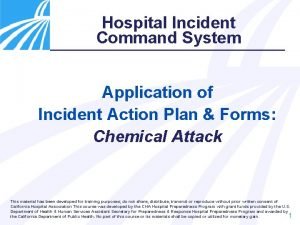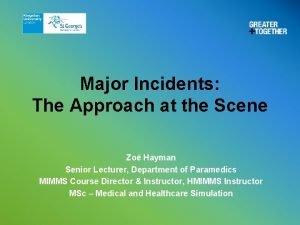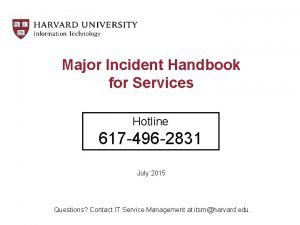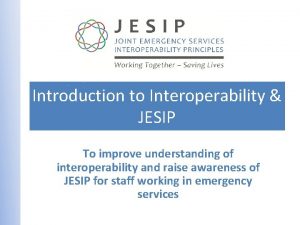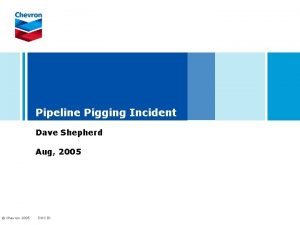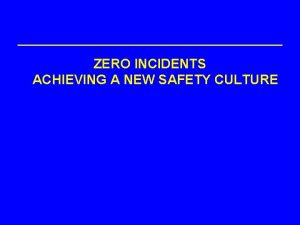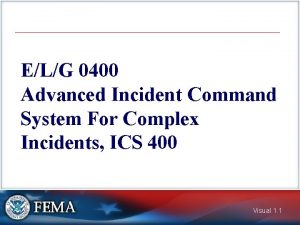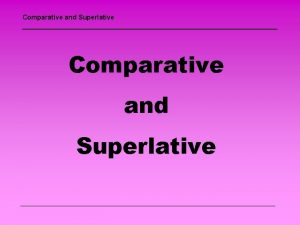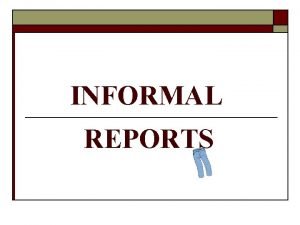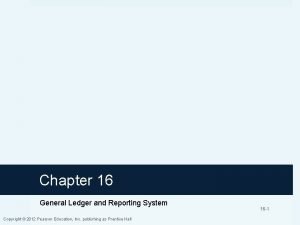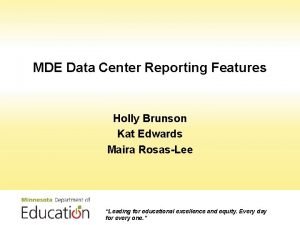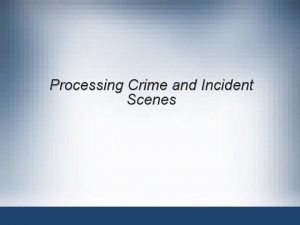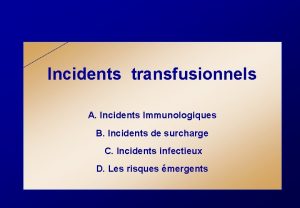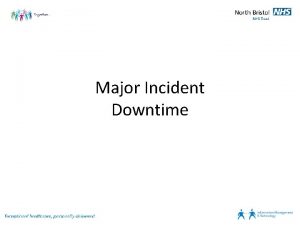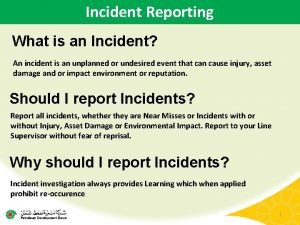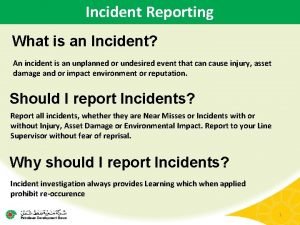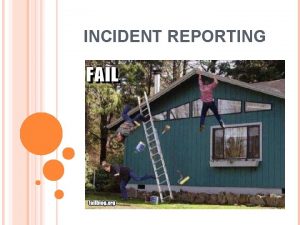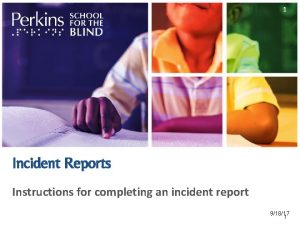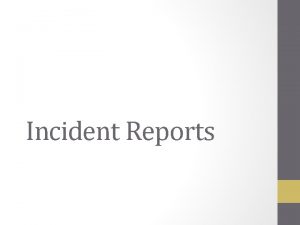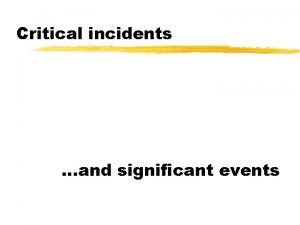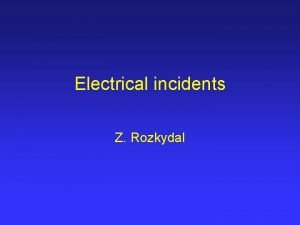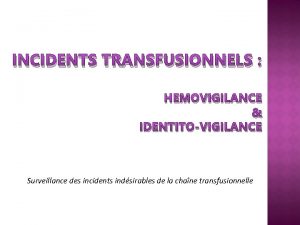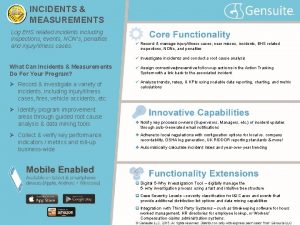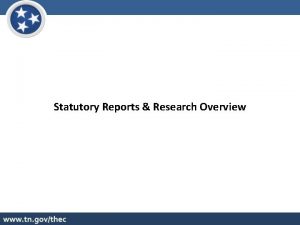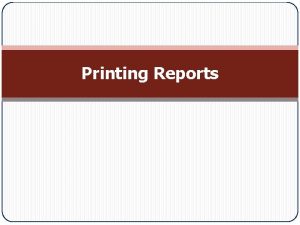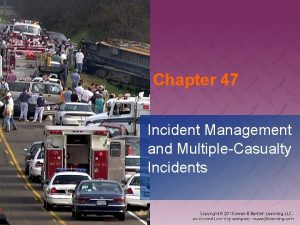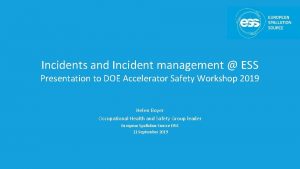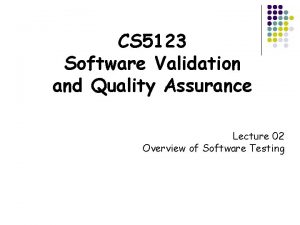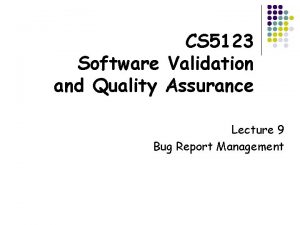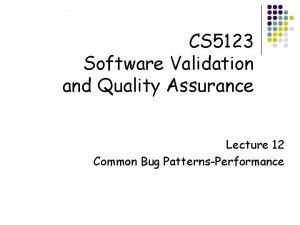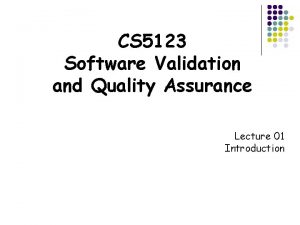UNUSUAL INCIDENT REPORTS AND MAJOR UNUSUAL INCIDENTS 5123

























- Slides: 25

UNUSUAL INCIDENT REPORTS AND MAJOR UNUSUAL INCIDENTS

5123: 2 -17 -02 (M)(2)(d) “Requires the agency provider to investigate unusual incidents, identify the cause and contributing factors when applicable, and develop preventative measures to protect the health and welfare of any at-risk individuals”.

What is an Unusual Incident “Unusual Incident" means an event or occurrence involving an individual that is not consistent with routine operations, policies and procedures, or the individual's care or service plan, but is not a major unusual incident.

Because you are the agency provider at the time of the unusual incident, you are the most knowledgeable about the situation. You have the facts and ready access to the individual.

What information must be included on the Unusual Incident Report (UI) • Individual's name; • Individual's address; • Date of incident; • Location of incident; • Description of incident; • Type and location of injuries; • Immediate actions taken to ensure health and welfare of individual involved any at -risk individuals; • Name of primary person involved and his or her relationship to the individual; • Names of witnesses; • Statements completed by persons who witnessed or have personal knowledge of the incident; • Notifications with name, title, and time and date of notice; • Further medical follow-up; and • Name of signature of person completing the incident report.


An effective incident report will tell you. . . • Who: • When: • Where: • What: Individuals and staff involved Date and time of incident Location of the incident What happened before, during (detailed account) and after the incident (immediate action)

“Description of Incident” should include. . . • Describe incident in chronological order. • Identify conditions that existed. • Prior action may or may not have caused the incident (may appear unrelated, but a pattern may later emerge). • If staff were involved, what response and action did staff take? • Describe what was said. Use quotation marks only if you are absolutely sure of the words used. • It is important that the health and safety needs of persons involved were addressed first, and that the documentation reflects that priority. • What is the status and condition of person(s) involved?

Immediate Actions. . . Always document what actions were taken following the incident (if applicable) • Assessed for Injuries • Called 911 • Initiated First Aid • Separated the Individuals • Notified Law Enforcement • Notified the County Board/SSA

Follow Up Actions. . . • Document all persons notified, attempts made to reach them, and actual contact, with the dates and times included. • Document any follow-up actions, especially for injuries and health conditions, to assure that proper care was given.

“Causes and Contributing Factors”. . . What is a cause? • A cause is a condition that produces an effect. • Remember—the cause of an incident is the reason WHY the incident occurred. What is a contributing factor? • A contributing factor is a condition that influences the effect by increasing its likelihood, accelerating the effect time, affecting severity of the consequences. • Remember—the contributing factor is what circumstances increased the likelihood of an incident.

Elements of a Prevention Plan. . • Should reduce the likelihood of future occurrences. • Should address each cause identified. • Should address other significant factors that played a role in the incident. • Should be specific in identifying WHO is going to do WHAT, WHEN, WHERE, and HOW. • Should have reasonable solutions that are attainable. EXAMPLES OF NOT SO EFFECTIVE PREVENTION PLANS. . . • Continue to monitor or follow the plan • Implement plan as written • Told him/her not to do that or remind individual to be careful


REQUIREMENTS FOR UNUSUAL INCIDENTS AND UI LOGS Each agency provider and independent provider shall review all unusual incidents as necessary, but no less than monthly, to ensure appropriate preventative measures have been implemented and trends and patterns identified and addressed as appropriate. Each agency provider and independent provider shall maintain a log of all unusual incidents. The log shall include, but is not limited to, the name of the individual, a brief description of the unusual incident, any injuries, time, date, location and preventative measures. • Log includes good immediate actions such as medical assessments, protections for individuals, etc. • There are no blank sections. • “Unknown” is rarely used. • Prevention Plans are specific and address the cause and contributing factors.

What is a UI Trend. . . • Three of the same or similar incidents in a week or five in a month. Why Are UI Logs Important. . . • UI logs will help you identify Trends and Patterns that need to be addressed to ensure the health and welfare of those we serve. • To ensure that sound preventative measures are in place. • It is required that ALL PROVIDERS complete monthly UI logs. • DODD will review UI logs during compliance reviews.

Role of the Provider in UI Trends. . . • 5123: 2 -17 -02 (M)(2)(6, 8, 9) • (6)Each agency provider and independent provider shall review all UIs at least monthly to ensure appropriate preventative measures have been implemented and trends/patterns are identified and addressed as appropriate. • (8) Each agency provider and independent provider shall maintain a log of all UIs. The log shall include the name of the individual, a brief description of the incident, injuries, time, date, location, and preventative measures. • (9) The agency provider and the county board shall ensure that trends & patterns of UIs are included and addressed in the ISP of each individual affected.

• An incident report may be subpoenaed at any time. • Your signature indicates that the document is truthful and inclusive. • All incident reports should be objective and factual— never include speculation or opinions. • An incident report may be your only form of proof that an incident occurred and the actions you took in regard to the incident.

Addendums and Changes for the Providers Because of the privatization of both SASS and SES, addendums will need to be created in order to change the Provider of Record.



SSA MONITORING FREQUENCY GUIDELINE


Beginning May 1, if you are need of assistance from HOPE Services after designated office hours, please call 419 -599 -2892. After you hear the recorded message, press 6 to reach the SSA on-call. You can also call 1 -800 -468 -HELP for further assistance from the local behavioral health hotline.

NEXT PROVIDER MEETING THURSDAY, SEPTEMBER 27, 2018

 Is a report formal or informal
Is a report formal or informal Incident objectives that drive incident operations
Incident objectives that drive incident operations Cscattt methane
Cscattt methane Major incident
Major incident Golden hour principles
Golden hour principles Gatsby chapter 3 questions
Gatsby chapter 3 questions Pipeline pigging incidents
Pipeline pigging incidents Why computer incidents are so prevalent
Why computer incidents are so prevalent Zero incident process
Zero incident process Safety rule violations can cause hunting incidents
Safety rule violations can cause hunting incidents Mulan falling action
Mulan falling action Advanced incident reporting system
Advanced incident reporting system Plot arrangement
Plot arrangement Role of nurse in maintaining records and reports
Role of nurse in maintaining records and reports Writing and completing reports and proposals
Writing and completing reports and proposals What is form control in system analysis and design
What is form control in system analysis and design Completing reports and proposals
Completing reports and proposals Famous adjective comparative
Famous adjective comparative Michaels cue bids
Michaels cue bids Conclusion for project
Conclusion for project Presenting insights and findings
Presenting insights and findings Formal business report
Formal business report The basic activities in the glars are
The basic activities in the glars are Mde data reports and analytics
Mde data reports and analytics Salesforce reports and dashboards training
Salesforce reports and dashboards training Processing crime and incident scenes
Processing crime and incident scenes

